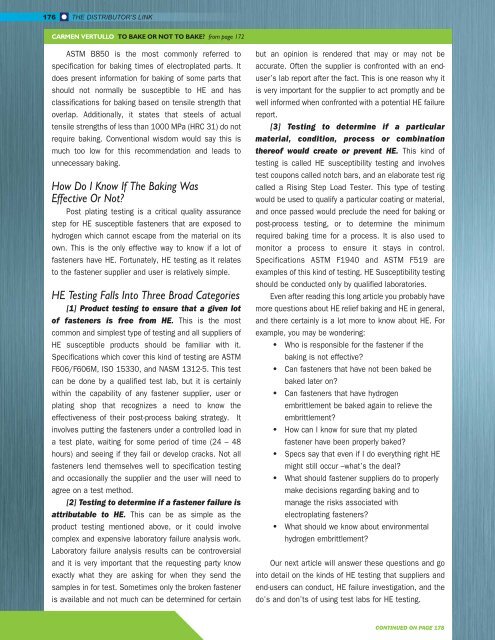WINTER 2016
Distributor's Link Magazine Winter Issue 2016 / Vol 39 No1
Distributor's Link Magazine Winter Issue 2016 / Vol 39 No1
You also want an ePaper? Increase the reach of your titles
YUMPU automatically turns print PDFs into web optimized ePapers that Google loves.
176 THE DISTRIBUTOR’S LINK<br />
CARMEN VERTULLO TO BAKE OR NOT TO BAKE? from page 172<br />
ASTM B850 is the most commonly referred to<br />
specification for baking times of electroplated parts. It<br />
does present information for baking of some parts that<br />
should not normally be susceptible to HE and has<br />
classifications for baking based on tensile strength that<br />
overlap. Additionally, it states that steels of actual<br />
tensile strengths of less than 1000 MPa (HRC 31) do not<br />
require baking. Conventional wisdom would say this is<br />
much too low for this recommendation and leads to<br />
unnecessary baking.<br />
How Do I Know If The Baking Was<br />
Effective Or Not?<br />
Post plating testing is a critical quality assurance<br />
step for HE susceptible fasteners that are exposed to<br />
hydrogen which cannot escape from the material on its<br />
own. This is the only effective way to know if a lot of<br />
fasteners have HE. Fortunately, HE testing as it relates<br />
to the fastener supplier and user is relatively simple.<br />
HE Testing Falls Into Three Broad Categories<br />
[1] Product testing to ensure that a given lot<br />
of fasteners is free from HE. This is the most<br />
common and simplest type of testing and all suppliers of<br />
HE susceptible products should be familiar with it.<br />
Specifications which cover this kind of testing are ASTM<br />
F606/F606M, ISO 15330, and NASM 1312-5. This test<br />
can be done by a qualified test lab, but it is certainly<br />
within the capability of any fastener supplier, user or<br />
plating shop that recognizes a need to know the<br />
effectiveness of their post-process baking strategy. It<br />
involves putting the fasteners under a controlled load in<br />
a test plate, waiting for some period of time (24 – 48<br />
hours) and seeing if they fail or develop cracks. Not all<br />
fasteners lend themselves well to specification testing<br />
and occasionally the supplier and the user will need to<br />
agree on a test method.<br />
[2] Testing to determine if a fastener failure is<br />
attributable to HE. This can be as simple as the<br />
product testing mentioned above, or it could involve<br />
complex and expensive laboratory failure analysis work.<br />
Laboratory failure analysis results can be controversial<br />
and it is very important that the requesting party know<br />
exactly what they are asking for when they send the<br />
samples in for test. Sometimes only the broken fastener<br />
is available and not much can be determined for certain<br />
but an opinion is rendered that may or may not be<br />
accurate. Often the supplier is confronted with an enduser’s<br />
lab report after the fact. This is one reason why it<br />
is very important for the supplier to act promptly and be<br />
well informed when confronted with a potential HE failure<br />
report.<br />
[3] Testing to determine if a particular<br />
material, condition, process or combination<br />
thereof would create or prevent HE. This kind of<br />
testing is called HE susceptibility testing and involves<br />
test coupons called notch bars, and an elaborate test rig<br />
called a Rising Step Load Tester. This type of testing<br />
would be used to qualify a particular coating or material,<br />
and once passed would preclude the need for baking or<br />
post-process testing, or to determine the minimum<br />
required baking time for a process. It is also used to<br />
monitor a process to ensure it stays in control.<br />
Specifications ASTM F1940 and ASTM F519 are<br />
examples of this kind of testing. HE Susceptibility testing<br />
should be conducted only by qualified laboratories.<br />
Even after reading this long article you probably have<br />
more questions about HE relief baking and HE in general,<br />
and there certainly is a lot more to know about HE. For<br />
example, you may be wondering:<br />
• Who is responsible for the fastener if the<br />
baking is not effective?<br />
• Can fasteners that have not been baked be<br />
baked later on?<br />
• Can fasteners that have hydrogen<br />
embrittlement be baked again to relieve the<br />
embrittlement?<br />
• How can I know for sure that my plated<br />
fastener have been properly baked?<br />
• Specs say that even if I do everything right HE<br />
might still occur –what’s the deal?<br />
• What should fastener suppliers do to properly<br />
make decisions regarding baking and to<br />
manage the risks associated with<br />
electroplating fasteners?<br />
• What should we know about environmental<br />
hydrogen embrittlement?<br />
Our next article will answer these questions and go<br />
into detail on the kinds of HE testing that suppliers and<br />
end-users can conduct, HE failure investigation, and the<br />
do’s and don’ts of using test labs for HE testing.<br />
CONTINUED ON PAGE 178

















